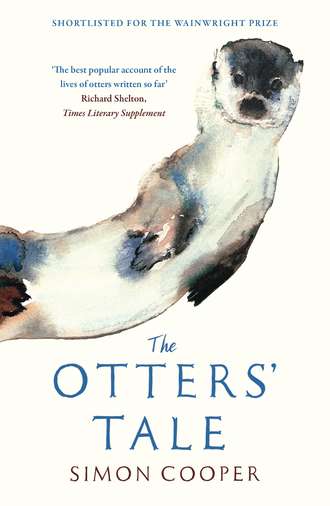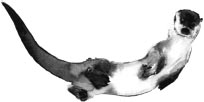
Полная версия
The Otters’ Tale
As luck (they finally got some) would have it, they had some breaks along the way: more legal protection, better environmental oversight of the watercourses and an explosion in the crayfish population – one of their favourite and most nutritious foods. All of this culminated in a survey published during 2011 that had found otters in all the forty-eight English counties, Kent being the last piece in the jigsaw. But don’t be under any illusions that the danger is over; they remain rare and under threat.
Kuschta knew nothing of her rarity, nor the perilous past her recent ancestors had trod to bring her to this point. All she knew was that The Badlands should be her home. A place good for otters, bad for people, as you’d struggle to walk across this landscape without considerable difficulty and deviations. A very long time ago this was water meadows, low-lying land in the flood plain that was deliberately ‘drowned’, covered by water diverted from the river during the winter and spring, to boost the growth of grazing pasture for sheep and hay making. It didn’t happen by accident; seventeenth-century Dutch engineers had been engaged by the large landowners, church and gentry to dig side streams or, as they are correctly known, carriers that were regulated by wooden hatches all along the valley that enabled and controlled the flooding. If you think of a human skeleton with the river as the spine and the ribs as the man-made channels, then you will get some idea of the layout. Long abandoned to nature, the defunct Dutch engineering now defines this landscape.
So where you would struggle, Kuschta revels. To start with, you’d have a hard time even entering her domain from most points of the compass, protected as it is by thick swathes of dense, prickly hawthorn, the vicious barbed sloe bushes and bramble briars. Of course, for her this presents no problem, slaloming between the stems, free to come and go at will and unnoticed. There is one gate to The Badlands, which is not much used and is your best entrance. From the gate it is hard to tell much about the landscape beyond, as almost all you can see is reeds. They stretch ahead of you, to the left and the right, almost to the height of a man, obliterating your view of the horizon. In the winter the reeds are desiccated, bleached to a dirty cream with the grass-like seed pods furling out of the top. Occasionally a small songbird, a wren or robin, will alight to the top of the stem, swaying perilously from side to side as it pecks for scarce food.
Too wet for people or cattle, the occasional visitors to The Badlands at this time of year are dogs; in time Kuschta learnt to recognise the sound of their imminent arrival as the beaters sweep the surrounding fields on shoot days. The guns sound in the distance. The horn wails to signal the start and end of each drive. The click-click-click and clack-clack-clack of the beaters tapping their sticks against the trees is interspersed by shouts as they clear the woods of birds. The wild fluttering of wings, as a pheasant takes flight, is followed by cries of ‘forward’ to alert the shooters of incoming sport. Sometimes Kuschta will feel the ground quiver as a shot bird thumps into the ground somewhere close by. Occasionally she’ll see the last twitches of life play out in front of her. Soon the gun dogs appear, splashing through the water and crashing through the reeds, directed by whistles and calls from afar. There is no subtlety to their arrival, playing havoc with the snipe and curlew who rise fast to the air in protest, the unwise making flight over the line of guns. In truth, dogs of the retrieving kind are not much worry to Kuschta. At first she had fled in terror, bolting from her couch to the safety of the river. But now, a few months on, she knows to hold her ground. Mostly the dogs are too intent on finding the birds to even notice her. If one does, she’ll snarl and hiss at the barking canine until the distant handler, frustrated by a dog going feral, calls it back with irritated shouts and shrill whistles. Soon the dogs retreat, the noises fade and The Badlands is at peace again.
The side streams, once the open channels that carried water across the meadows, are now both Kuschta’s paths and her larders. If The Badlands were shorn of vegetation you could very easily spot what are today effectively a series of parallel ditches about 50 yards apart, radiating at right angles away from the river, the ground between each rising and falling to create a gentle mound. From a distance it is a landscape that might look like a soft swell rolling in to a shore. If you choose to traverse The Badlands you’d be well advised to follow along the length of the mounds – they are relatively dry and firm underfoot. If you make your path by crossing the old streams in turn, prepare for a long and tiring effort. Though not exactly quicksand or bottomless pits, these are cloying obstacles, too wide to jump and with no firm crust to support even the lightest person. But otters? Well, that was altogether a different story.
Aside from the sheep set on The Badlands for a month of grazing in the late summer, rarely did anything of any size interrupt Kuschta’s rule of this stretch. Too wet for rabbits, badgers or foxes and away from human intervention, the largest, wildest thing that came through were startled deer on the run. With springing leaps they would clear the tops of the reeds, but the success of each leap would entirely depend on the landing – hit a mound and they sprang on at speed. Hit an old stream and it was all legs, mud and rasping gasps before hauling up and on the way again. It was an almost daily occurrence and Kuschta would listen out for it; as we’ll discover deer were her unwitting eel finders – an essential staple in the diet of an otter.
But if the eels, however accidentally uncovered, were the regular gift of nature, the manna from heaven was provided by me in the form of the trout lake at The Mill. No emaciated trout here, every one of them nourished daily with pellets, a true living larder. A popular winter venue, I’m always surprised Kuschta doesn’t visit it more often during the worst of times. It is only a mile or two from The Badlands so, as far as I can tell, far from being on the extreme edge of her territory. She could pretty well visit every night if she chose to, but despite the abundance of easy prey, she doesn’t. I often wonder why. It is said otters have a higher level of common sense than most other animals when it comes to their food sources, hunting in such a way that allows the population to regenerate rather than wiping it out. It sort of comes back to one of the multiple purposes of sprainting, an otter quality mark telling of what was caught where and when, providing a sort of self-regulation. But if I shared with Kuschta the truth – that I restock the lake to replace all the trout she takes – maybe she would alter her behaviour.
As it is, I’d estimate the visits are a bit more than every other day at this time of year. In my early years at the mill these losses used to annoy me; the fish corpses along the bank both a financial and emotional loss. I like fish as much as I do otters, but then I read a simple quote by I can’t remember who: ‘otters are rare, fish are common’. For some reason it struck a chord, and since then, though Kuschta’s pillage doesn’t exactly fill my heart with joy, I’ve accepted it as a price worth paying for the sight of a beautiful creature. That said, it doesn’t stop me sending a few choice curses her way when I see a fish with half a tail or a lacerated side.
In the winter she arrives at the lake early, and that always takes me by surprise. It shouldn’t really. My ‘early’ is judged against the human definition of nocturnal, let’s say 9pm to 6am, whereas hers runs from sunset – 4pm at the winter solstice – to sunrise at 8am. You’d think that those sixteen hours would be a massive opportunity for her to travel far, but otters are not active through every hour of darkness. They tend to pack the most into the first two or three hours, resting for the remainder until the last hour before dawn when they get busy again. It is not what you’d expect, but it is sometimes easier to find otters in winter than summer; it certainly does not involve all-night vigils. I’ll see Kuschta dive for cover as I nip out to catch the last post, or I’ll hear that tell-tale splash as I flick on the office lights to combat the gloom. If I’m out before sunrise for my morning checks of the river hatches we’ll often come face to face. The best is when she has a fish to eat. While she is intent on that, I will generally see her (the dreadful noise of her tearing apart the fish is always the giveaway) before she sees me. I can’t help myself, but I always creep up as close as I can. I guess I should circle around and leave her be, but the draw is too much. And the denouement is always worth it because when she finally sees me I can see in her expression a conflict of choices. Should she run and leave the fish, should she run with the fish, or should she stay put? It is mostly the first, straight into the lake. It is never the second, but very occasionally, mostly when she is blinded by wind and rain, it is the third. Whether it is bravery or the simple fact that she does not see me, I cannot judge, but I’ll do my bit, backing slowly away to leave her to it.
February did not disappoint. I always expect it to be the bleakest month of the year and this one proved to be equal to its fellows. There are no hints of spring, no harking back to the glories of autumn. Every day is the relentless winter. The landscape oozes cold and damp. But for all the deprivations, Kuschta was surviving well. As she passed her second birthday she was strong, fit and mistress of her domain. The valley was her place, providing all the shelter and food she needed as she ranged along its length. Naturally some days or weeks were better than others, but ultimately she only had herself to sustain in this solitary life. Strange though this might be, her whole life was predicated around the concept of being alone. She knew, of course, that she wasn’t, because as food became scarcer the more other otters passed through the valley, but she’d do everything she could to avoid contact. She’d sniff at the spraints of uninvited visitors before trumping them with her mark. She’d constantly patrol what she regarded as the core of her territory to ward off incomers. She had no curiosity to meet others and they had no curiosity to meet her. It is a great system, barring one thing – procreation.
Early March was not appreciably different to the month it left behind but for one thing – a scent. Kuschta picked it out from the air; the particular odour of a very particular stranger. In itself that wasn’t unusual, but this spoke to something deep inside her. Her first instinct was to double down on her territorial marking, but this time she paused, the particular dry muskiness percolating into a part of her brain that made her excited rather than fearful. Intrigued rather than dismissive. Curious, in fact. For a while she followed the trail, as it took her to higher ground, well away from anywhere she had been before. Eventually the unfamiliar landscape began to trouble her, so she turned back to home. As she slipped into the comforting embrace of her Badlands, bedding down in the dry shelter under one of the old brick culverts that harked back to the days when the water meadows operated, she was unsettled. For the first time since she had been abandoned by her mother, she felt the need to meet another otter. It was a need that was both visceral and strange, not least because it was that one particular otter. She wanted to ignore the urgings, but deep inside her something was changing that would never change back. She knew she must find this otter. But in truth, Mion was going to find her soon enough.
CHAPTER 4
ALONE BUT DETERMINED
Spring

Mion’s job, if his life may be described in such terms, is that of a grand overseer, protector and inseminator. Whereas Kuschta could cover her territory in a day if pressed, Mion ranged far and wide, taking as much as a week to cover his. It might be tempting to describe the four or five females that lived under his purview as his harem, but that gives a lie to his active involvement, suggesting that Kuschta and her gender are supplicants. They aren’t.
As the grand overseer, Mion had been aware of Kuschta from almost the very first day she arrived in the Wallop Valley, but chose to give her a wide berth, allowing her the freedom to mark out a home of her own. Two years her senior, he knew the valley better, confident of travelling further from the water than she was. With short cuts across fields at the junctions and bends of the river, he was able to dip in and out of her life unnoticed. Kuschta was too young for mating, so Mion was content to view her from afar until the time was right.
Like Kuschta, Mion tried to avoid conflict and interaction with other otters, but as the alpha male it was not always that simple. In truth, at somewhere between four and five years old, Mion was past his prime. Not in his dotage exactly, he had maybe one good year left, so, for now at least, young males mostly passed on and through the valley without challenging his authority. But it would not always be like that. There would come a time when Mion would have to fight for his dominance. For all their complex avoidance strategies, there is no way that otters are able to circumvent the Darwinian certainty of the survival of the fittest. There is some debate as to how much male otters fight. It is clear that they do fight, but nobody is exactly sure whether when two come head to head it comes down to a contest, or whether that is the choice of last resort. What is clear, however, is that it is simply not possible for two mature males to exist in harmony. One must give way to the other. The results will range from a mild confrontation to mortal injury.
Конец ознакомительного фрагмента.
Текст предоставлен ООО «ЛитРес».
Прочитайте эту книгу целиком, купив полную легальную версию на ЛитРес.
Безопасно оплатить книгу можно банковской картой Visa, MasterCard, Maestro, со счета мобильного телефона, с платежного терминала, в салоне МТС или Связной, через PayPal, WebMoney, Яндекс.Деньги, QIWI Кошелек, бонусными картами или другим удобным Вам способом.





